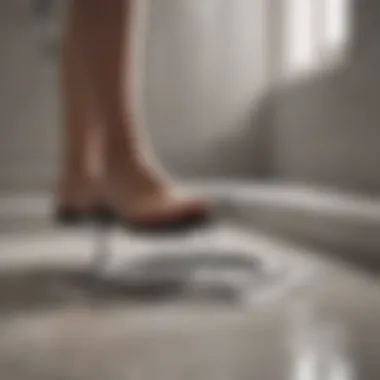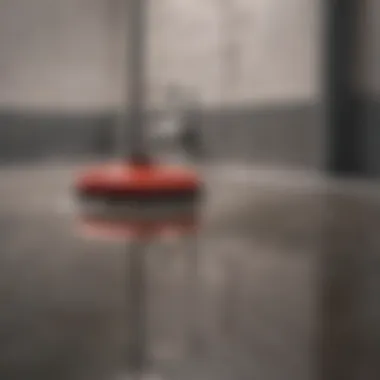Drano for Shower Clogs: Effectiveness and Safety Guide


Intro
Clogged showers are a common annoyance for many homeowners. Understanding how to manage these issues effectively is crucial, particularly as it relates to preventing further plumbing complications. This article delves into the practical application of Drano, a widely used chemical drain cleaner. We aim to provide insights on its effectiveness, safety, and alternatives available. This guide equips homeowners with indispensable knowledge for tackling shower clogs.
Understanding Shower Clogs
Showers can clog for several reasons. Hair, soap residue, and mineral buildup from hard water are among the most frequent culprits. Over time, these materials accumulate, leading to reduced drainage efficiency. Once a clog occurs, it is essential to address it quickly to avoid backup and potential damage to plumbing systems.
The Role of Drano
Drano, a popular drain cleaner, contains active ingredients designed to dissolve organic matter. The primary components include sodium hydroxide and aluminum, which react to create heat. This heat helps break down clogged materials.
However, while Drano can be effective, it is vital to consider its limitations and safety precautions during use. Always read the instructions on the label. Misusing the product can lead to damage to pipes or even personal injury.
Safety Considerations
- Personal Protection: Always wear gloves and eyewear when using Drano. The chemicals can be corrosive.
- Proper Ventilation: Ensure the area is well-ventilated. The fumes can be harmful if inhaled in high concentrations.
- Avoid Mixing: Never combine Drano with other cleaning products. The chemical reactions can produce toxic fumes.
Alternative Methods for Unclogging Showers
If Drano is not suitable or preferred, several alternative methods exist. These include:
- Boiling Water: Pour boiling water directly down the drain to help dislodge clogs.
- Baking Soda and Vinegar: This combination can create fizzing action that may help clear minor clogs.
- Plumbing Snake: A physical snake can be effective in removing stubborn clogs without chemicals.
Preventative Measures
After clearing a clog, prevention is key. Here are some effective strategies:
- Regular Cleaning: Use a drain cover to catch hair and debris. Clean it frequently to avoid buildup.
- Routine Maintenance: Periodic maintenance with baking soda and vinegar can keep drains clear.
- Educate Household Members: Teach everyone in your home about proper shower use to minimize clog risks.
Closure
In summary, understanding how to effectively use Drano for shower clogs is critical. It involves recognizing potential risks and employing safety measures. Furthermore, knowing alternative methods and preventive practices can significantly benefit homeowners in maintaining their plumbing systems. Mastery of these techniques allows for informed decision-making in addressing shower clogs securely and efficiently.
Understanding Shower Clogs
Shower clogs represent a significant inconvenience for homeowners, showing the need for awareness and understanding of this common plumbing issue. They often arise due to various factors, leading to slow drainage, unpleasant odors, and sometimes even water damage. Understanding the causes and signs of a clogged shower becomes essential in addressing these problems effectively and preventing future occurrences.
The importance of grasping how shower clogs develop lies in the ability to mitigate them before they escalate into more massive issues. Ignoring a minor blockage can eventually lead to a complete stoppage of water flow or unnecessary strain on plumbing systems. Additionally, with the increasing reliance on chemical solutions like Drano, it is crucial to know what leads to clogs, as this information can influence the choice of treatments available.
Common Causes of Shower Clogs
Shower clogs typically stem from a range of sources, and understanding these can help in prevention and diagnosis. Some of the most common contributors include:
- Hair: One of the primary culprits for clogging. Loose hair strands often accumulate in the drain, creating a thick barrier over time.
- Soap Residue: Used soap can leave behind oily deposits that easily trap hair and other debris, leading to blockages.
- Mineral Buildup: Hard water can lead to the accumulation of minerals inside the piping. This buildup hardens over time, reducing the diameter of the pipe and impeding water flow.
- Foreign Objects: Small items, such as toys, toiletries, or even jewelry, can inadvertently end up in the drain, causing obstructions.
Recognizing these causes may provide vital insight for those experiencing slow drainage. Regular inspections and maintenance can further mitigate the risks associated with these contributing factors.
Signs of a Clogged Shower
Identifying the signs of a clogged shower early can save homeowners time and expense in the long run. Key indicators that you might be dealing with a blockage include:
- Slow Drainage: When water accumulates in the shower and takes longer than usual to drain, it may indicate a clog is forming.
- Unpleasant Odors: If you notice foul smells coming from the drain, it could be due to decomposing debris building up.
- Gurgling Sounds: Unusual noises from the drain often indicate trapped air, a clear sign of impending clogging.
- Water Backups: This is one of the more noticeable signs. If water begins to back up into the shower or other drains, it confirms a significant blockage.
By staying alert to these signs, homeowners can take proactive steps to prevent further issues. Ignoring these signals can lead to more serious plumbing challenges.


"Early detection is key in managing plumbing issues efficiently."
Prolusion to Drano
Understanding Drano is essential for homeowners facing recurring shower clogs. It is commonly used to dissolve hair, soap scum, and other debris that can lead to blocked drains. Knowing how it works, along with its benefits and potential drawbacks, can assist you in making informed decisions regarding its use. This section will clarify the nature of Drano and its chemical makeup, providing context for its effectiveness as a drain cleaner.
What Is Drano?
Drano is a popular brand of chemical drain cleaner recognized for its ability to swiftly unclog drains in various settings, including showers. First introduced in 1923, Drano works through a combination of powerful ingredients that react with clogs. Users appreciate its efficiency, as it often provides quick results in mere minutes. Many homeowners rely on this product due to the convenience it offers, fitting seamlessly into busy lifestyles.
The application of Drano involves pouring the liquid into the clogged drain and allowing it to sit for a specified time, typically 15 to 30 minutes. During this time, the chemicals penetrate the clog, helping to break it down before flushing it away with hot water.
Components of Drano
Drano consists of several key ingredients, each contributing to its overall effectiveness. Generally, these components include:
- Sodium hydroxide: This is the primary active ingredient. It is highly corrosive and works to break down organic material.
- Aluminum: Often included in granulated forms, aluminum reacts with sodium hydroxide, producing heat that aids in dissolving clogs.
- Surfactants: These are added to improve the spreadability and penetration of the cleaner, allowing it to coat the clog more effectively.
- Other additives: These can include fragrances and agents to manage foaming.
It's crucial to note that the effectiveness of these chemical ingredients can vary based on the nature of the clog. In some cases, especially with severe or prolonged clogs, Drano may not be sufficient. In such situations, alternative solutions or professional help may be required.
Effectiveness of Drano for Shower Clogs
The effectiveness of Drano for unclogging shower drains deserves careful attention, as it can significantly influence how homeowners address plumbing issues. Understanding how this chemical cleaner works can help determine its suitability for various clog situations. While Drano can offer swift relief from clogs, the long-term effects of using such products require consideration as well.
Immediate Results
When Drano is poured down a clogged shower drain, it often provides immediate results. Typically, users report a noticeable decrease in water backup within a short period, sometimes as quickly as 15 minutes. This efficiency can be attributed to the strong caustic nature of Drano, which breaks down hair, soap scum, and other debris commonly found in shower drains.
"Many homeowners find Drano's quick action valuable during urgent plumbing situations."
The immediate results can be appealing, but users must follow the instructions carefully. Applying too much product may damage plumbing. Moreover, Drano should not be mixed with other cleaners, as this can produce dangerous chemical reactions. For those in a hurry, ease of application and speedy results are key benefits, making Drano a common go-to solution for clogged showers.
Long-Term Implications
While using Drano may quickly clear a clogged shower, there are long-term implications to consider. Over time, the repeated use of Drano can lead to potential damage to plumbing materials, especially older pipes. The corrosive nature of the product can weaken connections and fittings, resulting in leaks or more severe plumbing issues down the line.
In addition, users should be aware of how Drano affects overall plumbing systems. The chemicals can contribute to a buildup of residue within pipes if not rinsed thoroughly. This can create a cycle of recurring clogs, driving continued reliance on harsh chemical cleaners.
It is also worth mentioning the environmental aspect of using chemical drain cleaners like Drano. The impact on local water systems can be significant. Products that are not biodegradable can introduce harmful toxins into water supplies.
To summarize, while the immediate effects of Drano can be very effective in clearing clogged showers, it is prudent to consider the long-term ramifications for both plumbing integrity and environmental impact.
Usage Guidelines for Drano
When dealing with a shower clog, understanding the correct ways to use Drano is vital. Misuse can lead to ineffective results or even hazards such as pipe damage or chemical injuries. This section offers clear guidance on applying Drano correctly, ensuring not just an unclogged drain but safe practices as well. By following these guidelines, homeowners can minimize risks while effectively clearing their showers.
Step-by-Step Application
Using Drano effectively involves a simple, systematic approach. Here is how to use it:
- Preparation: Before applying Drano, ensure the area is well-ventilated. Open windows or turn on a fan to reduce the inhalation of fumes. Clear the shower area of personal items to prevent damage.
- Inspect the Drain: Check the shower drain for visible debris, hair, or soap residue. While Drano works on clogs, removing accessible materials helps it work more effectively.
- Reading Instructions: Always read the manufacturer’s instructions on the Drano product you are using. Different formulations may have varying requirements.
- Application: Pour the recommended amount of Drano directly into the drain. Avoid splashing or spilling it on surrounding surfaces.
- Let It Sit: Allow Drano to sit in the drain for the period recommended on the label. This usually ranges from 15 to 30 minutes, depending on the severity of the clog.
- Flush with Water: After the wait time, flush the drain with hot water. This helps to clear the drain of remaining residue and the chemical cleaner.
Following this procedure can lead to effective unclogging, enhancing your shower experience.
Dos and Don'ts


Being aware of what to do and avoid is crucial in using Drano safely and effectively. Here are some important dos and don'ts:
Dos:
- Do wear personal protective equipment like gloves and goggles when handling Drano. The chemicals can cause burns.
- Do work in a well-ventilated area to prevent chemical inhalation.
- Do follow the specific instructions provided on the product label carefully.
- Do keep Drano out of reach of children and pets. It can be harmful if ingested.
Don'ts:
- Don't mix Drano with other chemicals. This can cause dangerous reactions.
- Don't use it on toilets or sinks unless specified. Some formulations are specifically for showers.
- Don't pour excessive quantities in an attempt to speed up the clearing process. This can lead to pipe damage.
- Don't use on completely dry pipes as this may lead to insufficient contact time with the clog.
Adhering to these dos and don'ts promotes safety and enhances the effectiveness of Drano, ensuring a smooth unclogging process.
Safety Considerations
When dealing with clogged showers and using chemical solutions like Drano, safety should be the foremost priority. Understanding safety considerations helps prevent accidents and ensures effective cleaning without harmful outcomes. Proper knowledge can protect both the user and the environment, making the maintenance process less burdensome and more effective.
In this section, we’ll explore essential safety protocols and protective gear to consider when using chemical drain cleaners. The emphasis is on mitigation of risks associated with handling these substances, which is vital for both personal well-being and the longevity of plumbing systems.
Chemical Safety Protocols
Chemical safety protocols are an essential element when using products like Drano to unclog showers. It is important to follow these guidelines to minimize exposure to harmful substances and ensure proper usage of the product. Here are some key protocols to observe:
- Read the Label: Always read the product label and safety information. Every Drano variant has specific instructions and warnings that are crucial to follow.
- Ventilation: Ensure the area is well-ventilated. Open windows or use fans to disperse fumes that may be irritating.
- Avoid Mixing Chemicals: Never mix Drano with other cleaners. This can cause dangerous chemical reactions.
- Proper Disposal: Dispose of any unused product according to local disposal guidelines. This helps prevent environmental contamination.
Following these protocols not only protects you but also the plumbing system and the surrounding environment. In addition, it underscores the significance of informed decision-making in home maintenance tasks.
Personal Protective Equipment
Personal protective equipment (PPE) is crucial when using chemical drain cleaners to provide a safeguard against potential hazards. Here are essential items one should consider:
- Gloves: Use rubber or latex gloves to protect skin from chemical burns. Direct contact with Drano can cause skin irritation.
- Goggles: Protective eyewear will shield your eyes from splashes. If Drano splashes into the eyes, it can cause severe irritation and should be rinsed immediately.
- Mask: A dust mask or respirator can help reduce inhalation of fumes. This is especially important in poorly ventilated areas.
Having the right protective gear is a decisive factor in ensuring that the cleaning process is safe and effective. Taking these precautions can mitigate risks significantly, promoting a safer environment while dealing with tough shower clogs.
Environmental Impact of Chemical Drain Cleaners
Understanding the environmental impact of chemical drain cleaners, such as Drano, is crucial. These substances can have repercussions not only on plumbing systems but also on ecosystems and water supplies. While they may offer quick solutions for household clogs, it is important to consider the broader implications of their use.
The chemicals in conventional drain cleaners can lead to contamination of water sources. When used, these cleaners enter the plumbing systems and may not always dissolve completely. Consequently, they can eventually reach local waterways, potentially harming aquatic life and ecosystems. This raises concerns about the long-term sustainability of using these products.
Effects on Water Supply
Chemical drain cleaners can have adverse effects on the water supply. When these chemicals are washed down the drain, they can contaminate groundwater and surface water. This poses significant risks since many communities rely on these sources for drinking water.
- Chemical Residue: Some components of drain cleaners do not break down easily, leading to chemical build-up in water bodies.
- Harmful Substances: Common ingredients in Drano, like sodium hydroxide and bleach, can be dangerous to fish and other aquatic organisms.
- Public Health Risk: Contaminated water supplies can increase the risk of public health concerns, forcing municipalities to invest in advanced purification systems.
In sum, the direct and indirect effects of chemical drain cleaners on water supply can be detrimental, prompting a need for responsible usage or alternate methods.
Alternatives to Chemical Cleaners
In light of the environmental concerns associated with chemical drain cleaners, exploring alternatives is becoming increasingly important. Several options can help manage shower clogs without the harmful impact on water ecosystems.
- Baking Soda and Vinegar: This classic combination can be effective in breaking down minor clogs. The reaction between baking soda and vinegar helps dislodge debris in pipes.
- Hot Water: Pouring hot water down the drain can assist in dissolving grease or soap buildup.
- Natural Enzymatic Cleaners: These are made with non-toxic ingredients that break down organic material. They are safer for both plumbing and the environment.
- Physical Methods: Tools such as plungers or snake augers can remove clogs without any chemicals. This method is practical and avoids the risks associated with chemical cleaners.
Choosing eco-friendly alternatives can mitigate the adverse effects of traditional chemical drain cleaners on the environment. Homeowners can protect their plumbing and local ecosystems by making informed decisions about the products they use.


Professional Consultation
When dealing with persistent shower clogs that simple household measures cannot resolve, seeking professional consultation becomes vital. This step is often overlooked, yet it may provide the most effective solution to a challenging problem.
Professional plumbers bring expertise that is difficult to match with DIY methods, particularly when clogs are deep within the drainage system. Their training allows them to identify the underlying issues that may not be apparent to homeowners. This could range from buildup of hair and soap residue to more serious problems such as pipe damage or corrosion.
Moreover, proper consultation minimizes the risk of damaging plumbing with harsh chemicals. While Drano can be effective in the short term, improper usage can further complicate the situation. A professional can assess whether a chemical cleaner is necessary or if alternative methods should be pursued.
When to Seek Help
Identifying the right moment to call a professional can save time and prevent costly repairs down the line. Homeowners should consider consultation when:
- Persistent Clogs: If clogs recur despite attempts with Drano or other drain cleaners, this indicates a deeper issue within plumbing.
- Multiple Affected Drains: Water backing up in multiple locations is often a sign of a broader problem, such as blockages in the main sewer line.
- Unusual Odors: Foul smells can point to stagnant water caused by serious blockages.
- Frequent Gurgling Sounds: This might indicate trapped air and should not be ignored.
- Visible Damage: Signs like water stains or swelling in walls or cabinets could imply a plumbing issue that needs immediate attention.
In these cases, consulting a professional not only assures the integrity of plumbing but can also provide peace of mind.
Choosing the Right Professional
Selecting a trustworthy plumbing professional can feel daunting, but certain strategies can simplify the process. Focus on these elements when making your choice:
- Experience and Qualifications: Ensure the plumber has adequate experience dealing with shower clogs. Check their credentials to confirm qualifications.
- References and Reviews: Look for testimonials from previous clients. Websites like Reddit can be helpful for real experiences.
- Service Range: Confirm they can handle both minor clogs and more significant plumbing issues. A versatile plumber can better respond to unforeseen complications.
- Transparency in Pricing: Professionals should provide clear estimates before starting any work. Hidden fees can create distrust and financial strain.
- Emergency Services: A good plumber should offer emergency assistance. This is especially crucial in the event of extensive water damage.
By following these guidelines, homeowners can effectively navigate the sometimes complex world of plumbing services, ensuring their shower clogs are dealt with promptly and professionally.
Preventive Maintenance for Showers
Preventive maintenance for showers is an essential practice that cannot be overlooked. By implementing proactive measures, homeowners can reduce the likelihood of clogs and other plumbing issues that often arise from neglect. Regular maintenance not only extends the lifespan of shower fixtures but also ensures that they function optimally. A systematic approach to maintaining showers can save money in repair costs and contribute to a more pleasant and efficient bathing experience.
Regular Cleaning Practices
To maintain a clear and functional shower, regular cleaning is vital. This includes not only the showerhead and tiles but also the drainage system.
Here are some points to consider for effective cleaning practices:
- Frequency: Establish a regular cleaning schedule, ideally weekly. This routine can prevent soap scum, dirt, and hair debris from accumulating and blocking drainage.
- Proper Cleaning Agents: Use non-abrasive cleaners that are safe for both ceramic and plastic surfaces. Avoid harsh chemicals as they can damage the finish on fixtures.
- Attention to Corners and Grout: Areas prone to mold and mildew, such as grout lines, should receive special attention. A mixture of vinegar and water can help dissolve buildup without damaging surfaces.
Incorporating these cleaning habits cultivates an environment that keeps water flowing freely and prevents issues before they arise.
Usage of Drain Screens
Drain screens act as a barrier against debris entering the plumbing system. They are simple yet effective tools that can significantly reduce the volume of materials that contribute to clogs. To make the most out of drain screens, consider the following:
- Easy Installation: Most screens are easy to install and fit snugly over the drain opening, requiring no specialized tools.
- Regular Cleaning: Like all components of a shower, drain screens must be cleaned regularly to remove hair and soap residue. This maintenance step is quick and has substantial benefits.
- Variety of Designs: Available in various shapes and sizes, homeowners can find screens that match their decor while still providing effective coverage.
Incorporating drain screens into the shower setup not only reduces the likelihood of clogs but also enhances the ease of keeping the shower clean.
Regular preventive maintenance, including cleaning and the use of drain screens, is a cost-effective way to ensure that plumbing systems work smoothly and effectively.
Closure
The conclusion serves as a crucial component of this article by encapsulating the main themes discussed regarding the use of Drano for shower clogs. Understanding the functionalities, benefits, and drawbacks of this product provides clarity and equips readers with knowledge to handle plumbing issues effectively. By weighing the options presented throughout this guide, individuals can make discerning choices based on their unique circumstances and preferences.
Weighing the Options
As homeowners, it is essential to evaluate whether Drano is the right solution for specific shower drain problems. While many appreciate the convenience of chemical drain cleaners, like Drano, there are trade-offs to consider. For instance, while Drano can provide quick relief to clogged drains, its long-term effects on plumbing systems and the environment should not be overlooked. Chemical alternatives may be effective, yet they might pose risks to health and safety if not used properly.
- Efficacy: Drano works well for minor clogs but may not address severe blockages effectively.
- Safety: Users must adhere strictly to safety guidelines when using this product.
- Environmental Impact: Assess the ecological ramifications of using chemical cleaners. Prefer eco-friendly methods when possible.
With these factors in mind, evaluate whether regularly scheduled maintenance, a professional plumbing inspection, or more environmentally sound approaches might better suit the situation.
Final Thoughts on Drano's Use
Drano remains a popular choice among homeowners for its immediate results in combating shower clogs. However, users should prioritize safety and environmental considerations when applying this chemical solution. It is best practice to avoid over-reliance on products like Drano, considering that the consistent use may lead to unforeseen plumbing issues and potential harm to the environment.
"While Drano can effectively alleviate minor blockages, one must not ignore the long-term health of the plumbing system."







